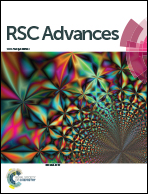Tetraphenylethylene- and fluorene-functionalized near-infrared aza-BODIPY dyes for living cell imaging†
Abstract
Four near-infrared (NIR) boron-azadipyrromethene (aza-BODIPY) dyes 5a–d bearing tetraphenylethylene- and fluorenyl substituents at the 1,7-position or 3,5-position were synthesized and characterized by 1H NMR, 13C NMR and HRMS. The single crystal structure of compound 5c was studied by X-ray crystallography. UV/vis and fluorescence spectroscopic studies of the aza-BODIPY dyes 5a–d indicated that the absorption and emission maxima of these dyes were bathochromically shifted up to 48 nm in comparison with that of the 1,3,5,7-tetraphenyl aza-BODIPY. Moreover, fluorescence quantum yields up to 0.45 were observed for the new dyes. The redox properties of these dyes were investigated by cyclic voltammetry. The observed optical and electrochemical properties of these dyes were further elucidated by the DFT calculation of the frontier molecular orbitals. Owing to their outstanding fluorescence properties, these dyes can be applied as fluorescence imaging probes for living cells.



 Please wait while we load your content...
Please wait while we load your content...